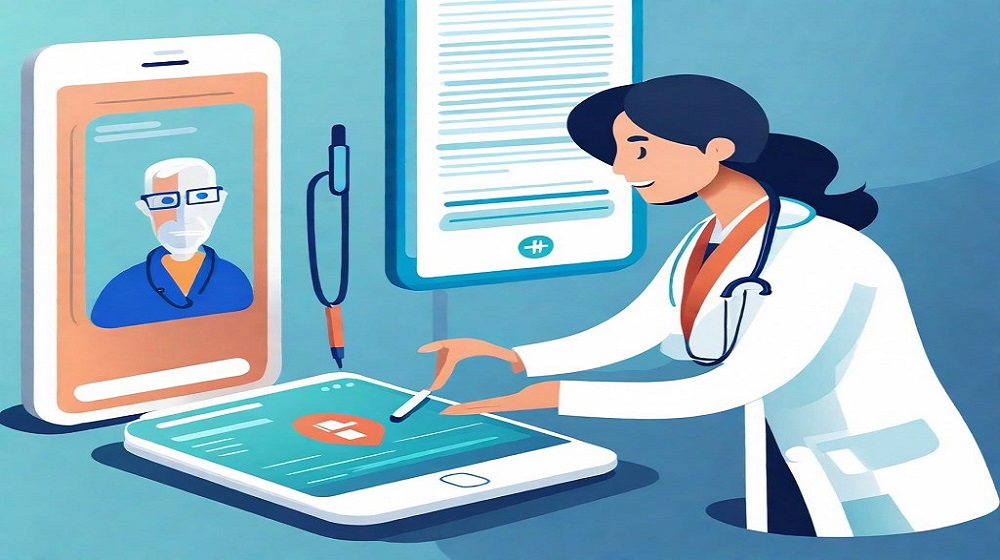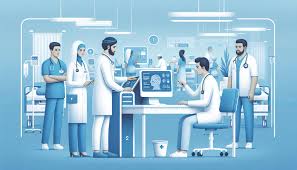How AI Medical Scribes Are Transforming Healthcare Workflows
The increasing adoption of Artificial Intelligence (AI) in healthcare has significantly transformed the way healthcare providers manage patient care, documentation, and workflows. Among the many advancements, AI medical scribes stand out as one of the most promising tools to revolutionize healthcare workflows by automating medical documentation and freeing up physicians to focus more on patient care. AI medical scribes utilize advanced algorithms, natural language processing (NLP), and machine learning to record and transcribe physician-patient interactions in real-time, providing an efficient alternative to traditional methods of medical documentation.
This blog will explore how AI medical scribes are transforming healthcare workflows, improving efficiency, and helping healthcare providers better manage clinical data management, patient interactions, and administrative tasks.
What is a Medical Scribe and How AI is Redefining the Role?
The Question is that what is a medical scribe? A medical scribe is traditionally a person who documents real-time interactions between healthcare providers and patients during consultations. The scribe’s role is to ensure that medical records are accurate, comprehensive, and up-to-date. However, the introduction of AI is revolutionizing this role by automating much of the documentation process.
- AI medical scribes function as virtual assistants that automatically transcribe physician-patient interactions into electronic health records (EHRs). This eliminates the need for human scribes and reduces the likelihood of human error.
- Unlike traditional scribes, AI-driven systems can process vast amounts of data quickly and accurately, ensuring that all relevant information is captured and entered into the patient’s medical record without delays.
This transition from human to AI-powered medical transcription helps physicians save time and focus more on providing quality patient care. It also ensures that healthcare documentation is always precise, compliant, and easily accessible.
The Impact of AI Medical Scribes on Healthcare Workflows
AI has a profound impact on the healthcare industry, and its influence is particularly evident in improving healthcare workflows. AI medical scribes are designed to automate routine tasks, reduce administrative burden, and increase the overall efficiency of healthcare providers. Here’s how they are transforming healthcare workflows:
Improved Efficiency in Patient Care
With the integration of AI for healthcare workflow, physicians no longer have to spend a significant amount of time documenting patient interactions. AI scribes transcribe interactions in real-time, updating patient records instantly.
- A recent study published by the American Medical Association shows that physicians spend nearly half of their workday on documentation tasks. The adoption of AI medical scribes could cut this time by more than 30%, allowing physicians to spend more time with patients.
- This increase in efficiency not only improves patient care but also helps reduce physician burnout, a growing concern in healthcare today.
Streamlined Clinical Data Management
Clinical data management is crucial in maintaining accurate patient records and ensuring that healthcare providers have access to up-to-date information. AI scribes help streamline this process by automatically organizing and updating clinical data during consultations.
- AI in patient data management helps reduce the risk of errors, ensuring that the data collected is accurate and comprehensive. This ensures that healthcare decisions are based on reliable and real-time information.
- For clinics involved in clinical trials, AI-powered medical transcription can also facilitate better clinical data management by ensuring that all interactions and patient responses are documented in compliance with regulatory standards.
Steps to Adopt AI Medical Scribes in Clinics

Integrating AI medical scribes into clinics is a transformative process that requires thoughtful planning and execution. Below are the essential steps for successfully adopting AI medical scribes:
Step 1: Assess the Need for AI Scribes
Before implementing AI scribes, clinics need to evaluate their current documentation processes to identify inefficiencies and determine how AI can help. Factors to consider include the time spent on documentation, accuracy of records, and physician workload.
- Clinics that experience high documentation loads or staff shortages may find AI medical scribes to be a practical solution for reducing administrative burden and improving patient care.
Step 2: Choose the Right AI Scribe Platform
Several AI-powered medical transcription platforms are available on the market, each offering different features. Clinics must choose the right solution that integrates seamlessly with their existing EHR systems and clinical workflows.
- Look for platforms that use advanced NLP algorithms to ensure the highest accuracy in transcription. Some platforms also offer customizable workflows tailored to the clinic’s specific needs.
Step 3: Train the Healthcare Staff
Introducing AI medical scribes requires healthcare providers and administrative staff to be adequately trained. Physicians need to know how to interact with AI systems to ensure accurate documentation, while support staff must be familiar with how to manage AI-generated records.
- Continuous training will ensure that physicians and staff are comfortable using AI scribes, leading to improved efficiency in daily operations.
Step 4: Monitor and Optimize the System
After implementation, it’s essential to monitor the performance of AI scribes and optimize the system to meet clinic-specific needs. Feedback from healthcare providers should be used to adjust workflows and ensure that the AI system is performing as expected.
How AI Medical Scribes Improve Efficiency in Healthcare
The primary reason why AI medical scribes are being adopted in healthcare settings is the remarkable efficiency they bring to both patient care and administrative workflows. Below are the key ways AI medical scribes improve healthcare efficiency:
Reduction in Documentation Time
As mentioned earlier, physicians spend a substantial amount of time on documentation tasks, which detracts from patient care. AI scribes reduce this documentation time by transcribing interactions in real-time, allowing physicians to focus more on diagnosing and treating patients.
- By automating these tasks, physicians can see more patients in less time without compromising the quality of care.
Improved Data Accuracy
One of the significant advantages of AI in patient data management is the enhanced accuracy of the records. Human error is common in traditional documentation, leading to incomplete or incorrect patient records. AI medical scribes use machine learning and NLP to ensure that every detail is captured accurately, reducing the likelihood of errors.
- Accurate data not only improves patient outcomes but also ensures compliance with healthcare regulations.
Enhanced Communication and Collaboration
Since AI medical scribes automatically update clinical data management systems in real-time, healthcare providers can access up-to-date patient records quickly. This seamless communication between departments ensures that all healthcare professionals have the information they need to make informed decisions about patient care.
The Future of AI Medical Scribes and Virtual Healthcare Assistants
The future of AI medical scribes looks promising as advancements in AI technology continue to evolve. In addition to automating medical transcription, future virtual healthcare assistants may take on even more roles, such as helping with patient scheduling, offering diagnostic support, and improving patient engagement.
- Medical AI Chatbot are already being used in healthcare to assist patients with their queries, appointment scheduling, and even providing preliminary diagnoses. When combined with AI medical scribes, these chatbots can further enhance clinical workflows by gathering patient information before consultations, ensuring that physicians have all necessary data readily available.
Moreover, AI-powered medical transcription will continue to advance in accuracy and capabilities, making it an indispensable tool in healthcare settings worldwide.
Conclusion
AI medical scribes are transforming healthcare workflows by automating the documentation process, streamlining clinical data management, and improving the efficiency of patient care. By reducing the administrative burden on physicians, AI scribes allow healthcare professionals to focus more on their patients, ultimately improving care quality and outcomes.
As healthcare technology continues to evolve, the role of AI-powered medical transcription and virtual healthcare assistants will only expand, leading to even greater improvements in workflow efficiency, data accuracy, and patient satisfaction. For clinics and hospitals looking to stay ahead, adopting AI medical scribes is an essential step toward a more efficient and patient-centered future.
FAQs Related to AI Medical Scribes
Q1: How do AI medical scribes improve efficiency in healthcare?
AI medical scribes improve efficiency by automating the transcription of physician-patient interactions, reducing the time spent on documentation and freeing up physicians to focus on patient care. They also enhance the accuracy of medical records, ensuring that healthcare providers have access to reliable and up-to-date patient information.
Q2: What are the steps to adopt AI medical scribes in clinics?
The steps to adopt AI medical scribes in clinics include assessing the need for AI scribes, choosing the right platform, training healthcare staff, and continuously monitoring and optimizing the system to meet the clinic’s specific needs. Proper implementation ensures that AI scribes integrate seamlessly into existing workflows.
Q3: What is a medical scribe, and how does AI enhance their role?
A medical scribe documents physician-patient interactions in real-time, ensuring accurate and comprehensive medical records. AI-powered medical transcription enhances the role of scribes by automating much of the documentation process, reducing human error, and improving workflow efficiency.
Q4: How does AI improve clinical data management?
AI improves clinical data management by automating data entry, organizing patient records, and ensuring that all information is accurate and compliant with healthcare regulations. This allows healthcare providers to make better-informed decisions and improves overall patient care outcomes.






